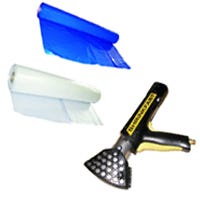Boat Winterization Tools & Accessories
Nobody enjoys boat winterizing their boat, but it pays off in spades come spring, when your boat is all ready to go — clean and dry with freshly changed fluids and charged batteries. » Read More
Learn More About Boat Winterization
Why Winterize Your Boat?
Unfortunately for most people, boating isn’t a year-round activity. There’s no set-in-stone latitude at which winterizing your boat becomes necessary, but if you experience freezing temperatures or plan to leave your boat in winter storage for an extended period, it’s a good idea to winterize your boat to prevent damage to engines, plumbing, and finishes.
So what are the steps to winterize a boat yourself? The process may look different from one boat to the next. There are different components on different boats to consider, but the main things to keep in mind are the motor, fuel, plumbing, and exterior and interior finishes. Read More
How to Winterize a Boat
As previously mentioned, winterizing techniques can vary from boat to boat, according to what type of drive system they use, whether it be outboard or inboard, and whether the boat has a cabin, sanitation system, and/or potable water system. On both outboards and inboards, steps to winterize a boat may vary between manufacturers, but it typically looks similar to the procedure provided below: Read More
As previously mentioned, winterizing techniques can vary from boat to boat, according to what type of drive system they use, whether it be outboard or inboard, and whether the boat has a cabin, sanitation system, and/or potable water system. On both outboards and inboards, steps to winterize a boat may vary between manufacturers, but it typically looks similar to the procedure provided below:
1. Treat Fuel and Fill Fuel Tank
When it comes to winterizing boat engines, the first thing to consider is fuel. On older boats with vented fuel tanks, fill your fuel tank up to almost full and treat them with a fuel stabilizer, such as Star Tron or Sta-Bil. By filling your tank up almost all the way, you’re limiting the amount of air in the tank that could cause condensation and ruin your fuel. Don’t fill your tank up all the way, as the fuel could run out of the vent if it were to expand on a warm day.
On fuel tanks without vents, treat the fuel with a fuel additive; there’s no need to top off the tank, as non-vented tanks can’t absorb water from the atmosphere. After you’ve treated your fuel, run your motor for approximately 10 to 15 minutes to make sure the treated fuel has been run into the motor. Do this on a garden hose or in the water. Following this, replace your fuel filter. This guarantees that your fuel systems are treated and gum-free for the following year.
2. Change Engine Oil and Gear Lube
At this point, it’s also a good idea to change your engine oil. Storing the motor with old oil allows contaminants in the used oil to corrode and deteriorate the internal components of your motor. While you’re at it, change your lower unit gear lube as well. Any water that may have found its way into your lower unit could expand and destroy your seals, or even crack your gear case. This step may not be required on straight-drive inboard boats, but consult your manual or manufacturer to be sure.
3. Fog Your Engine (if needed)
Fogging an engine is also a good idea before storing a boat; however, some motors should not be fogged! Fogging can also cause a runaway motor in diesels and damage some sensors and fuel injectors in new outboards. Always check your owner’s manual before fogging and follow manufacturer recommendations!
Fogging your motor involves coating the walls of your engine cylinders in oil to avoid any potential corrosion caused by moisture in your cylinders. Fogging procedures can involve spraying oil directly into the cylinder by removing the spark plugs or spraying directly into the intake by removing the air filter.
4. Drain Coolant and Water
For outboard-powered boats, the only step to winterizing the coolant system is to store the motor fully trimmed down. This allows any water in the cooling system to drain out on its own, removing any risk of ice. On boats with inboard engines, winterizing your coolant system is a bit more complex. In general, you will want to remove any untreated water from your coolant system and either replace it with antifreeze or leave it dry. Again, this can vary greatly from manufacturer to manufacturer so be sure to consult your owner's manual.
On boats with livewells, sewage containment systems, or freshwater systems, you will need to winterize those as well. On boats with livewells, make sure your system is drained completely. If it’s impossible to drain your system completely and there’s always a bit of water sitting somewhere, flush your system with antifreeze to ensure that only it is stuck in the livewell system.
5. Drain All Plumbing
For sewage systems, step one is making sure your holding tank is flushed out. This ensures you’re starting from new in the spring, and eliminates the risk of sewage water cracking or bursting your holding tank. After you have drained your tank, disconnect the pickup hose from your water pickup and place it in a bucket of antifreeze. Flush your head a few times to suck this antifreeze up and circulate it back into the holding tank.
Depending on how your raw water washdown pump is set up, winterizing them all at the same time may be as simple as running your raw water washdown while the pickup hose is in the antifreeze bucket. If you have multiple raw water pickups, be sure to winterize all of them before winter storage.
When using antifreeze to winterize boats, it’s important to use marine antifreeze and not automotive antifreeze for boat storage. Marine antifreeze is non-toxic and not as harmful to the environment as automotive antifreeze. Marine antifreeze also has rust and corrosion inhibitors that can help to protect your boat's plumbing. Marine antifreeze consists of propylene glycol, while ethylene glycol is the main ingredient of car antifreeze. When handling either type of antifreeze be sure to dispose of it properly, even if it is non-toxic.
6. Remove Batteries
Winterizing your electrical system is pretty simple. On boats stored on the trailer or a storage rack, remove your battery or batteries. Whether or not to plug your battery into a maintainer or not depends on the battery type.
Lithium-ion batteries are not designed to be stored fully charged for an extended amount of time. To maintain these batteries, store them inside until they completely discharge. Recharge them and disconnect them from the charger, allowing them to discharge completely again. Continue this cycle as long as necessary.
On AGM, and lead acid batteries, connecting them to a battery maintainer is the best course of action, as they benefit from being stored on a trickle charger. On lead acid batteries, check your fluid levels and add distilled water if necessary.
If possible, it’s a good idea to move your easily accessible electronics indoors for winter storage. Even though most marine electronics are tested to withstand extreme temperatures and conditions, storing at room temperature is best. If you can’t remove your electronics, make sure they’re covered and protected from the sun and moisture as part of your winterization routine.
7. Cover or Shrink Wrap Your Boat
Protecting the outside and inside of your boat, including upholstery, during winter storage periods is important too! There are different methods for this such as indoor storage, custom-made covers, and custom shrink wrapping. Indoor storage is preferred, but it can be expensive or simply not feasible depending on the size of your boat. Small trailer boats have an advantage here!
Canvas covers — especially custom-made to fit your boat — are a great option, but they can be prohibitively expensive for some boat owners. These covers may cost several thousand dollars, but they can last for years.
Shrink wrapping involves wrapping your boat in low-density polyethylene and applying heat to get it to shrink. This results in a watertight, weather-resistant cover that will protect your boat all winter. Shrink wrap can be a DIY project or you can have a professional do it. The up-front cost of wrapping is cheaper than the one-time cost of a custom-made cover, but wrapping is only good for one year as the materials aren’t meant to be reused.
8. Check all Systems
While you’re winterizing your boat it’s a good idea to check over all of your systems to make sure everything is in working order. While you’re doing everything else, it is never a bad idea to:
- Check your propeller shaft and propeller. Now is the perfect time to have your propeller re-hubbed or repaired.
- Check your sacrificial anodes (aka "zincs") now, while you have a few months to order and replace them.
- Lubricate any grease fittings. This can help purge any moisture or gunk from the boating season.
- Fluid film your power head with a product like Boeshield T-9 or CRC 6-56. This thin layer of oil can protect your power head from surface corrosion.
Winterizing your boat doesn’t have to be a sad event! Instead, use this time to get ahead on your preparations for the next fun-filled boating season!


